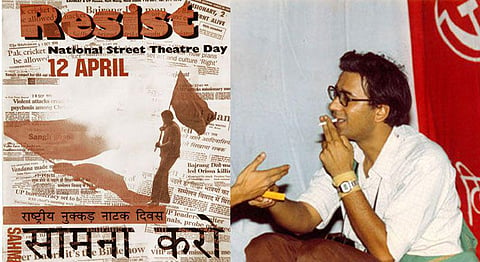
- HOMEGROWN WORLD
- #HGCREATORS
- #HGEXPLORE
- #HGVOICES
- #HGSHOP
- CAREERS
- ABOUT US
- CONTACT US

Political street theatre has a rich, albeit silenced, history in India, serving as a bold platform for communicating ideas, voicing opinions, and protesting dominant rule in the country. Activism and the arts are both as vital to a thriving democracy as any branch of government, but too often in India’s blood-stained past, those freedoms have been denied by political elites. In 1989, the Safdar Hashmi Memorial Trust – or Sahmat – released a simple poster that declared April 12 (marking Hashmi’s birth anniversary) as National Street Theatre Day. It also mentioned January 2, 1989 – the day Hashmi had been killed, after an attack on his performance troupe by Indian National Congress-backed goondas.
Safdar Hashmi was a brilliant communist playwright who significantly revolutionised political street theatre in India. He formed the renowned Jana Natya Manch (People’s Theatre Front), or JANAM (“birth”). It grew out of the Indian People’s Theatre Association (IPTA) and drew influence from the Communist Party of India (Marxist), with which Hashmi was actively involved. Prior to his death, the troupe had performed over 4000 plays at nearly 100 locations in working-class neighbourhoods, about issues ranging from inflation and the distress of small peasants, unemployment and “clerical fascism,” to sexual violence and the struggle for women’s rights. On January 1, 1989, Hashmi and his troupe were performing Halla Bol in Ghaziabad during its municipal elections when a group of thugs from the Congress party attacked them with iron rods and firearms. The following day, Hashmi succumbed to his injuries. Within a few weeks of this incident, writers, artists, poets, photographers and activists across the country came together to form Sahmat – a foundation created “to preserve the pluralist and democratic spirit of creative expression.”
Every year, Sahmat honours Hashmi by releasing a poster that is sent to thousands of street theatre groups around the country, who in turn use them on their April 12 performances. The posters soon evolved into informative, thematic ones relating to issues of free speech and political expression, with designers and activists contributing to each one. They present alternative sociocultural narratives of political events, challenge pre-existing understandings of history and celebrate thinkers who inspire the Sahmat community and the Indian Left. The idea was that an artistic, graphic representation would be more engaging for young audiences and a unifying force of mobilisation.
Sahmat posters cover a wide range of interesting content. The 1992 poster, made after the demolition of Babri Masjid in Ayodhya, “was intended to raise questions and talk about issues related to that demolition,” said Ram Rahman, one of the founding members of Sahmat. The 1998 poster was a tribute to German poet Bertolt Brecht, featuring his famous quote in both English and Hindi: “In the dark times, will there also be singing? Yes, there will be singing about the dark times.” The 2010 poster, on exile and love, was designed by MF Husain, featured words by Edward Said, and was dedicated to Pakistani Leftist poet Faiz Ahmed Faiz. The 2018 poster – titled “Kisaan Bachao, Desh Bachao” – depicts the February marches by farmers demanding loan waivers and more government support for their crops.
Collectively the Sahmat posters are a revolutionary, comprehensive archive of the diverse histories and political realities of India. Today, both Sahmat and JANAM live on, and street theatre is a common form of protest among college students against caste-based discrimination and killings, agrarian crises and corruption. Hashmi’s unbridled legacy has strengthened the resolve and fiercely inspired young people working fearlessly for a radically better India.
Feature image credits: (L) Sahmat and (R) Jana Natya Manch.
If you enjoyed this, we suggest you read:
